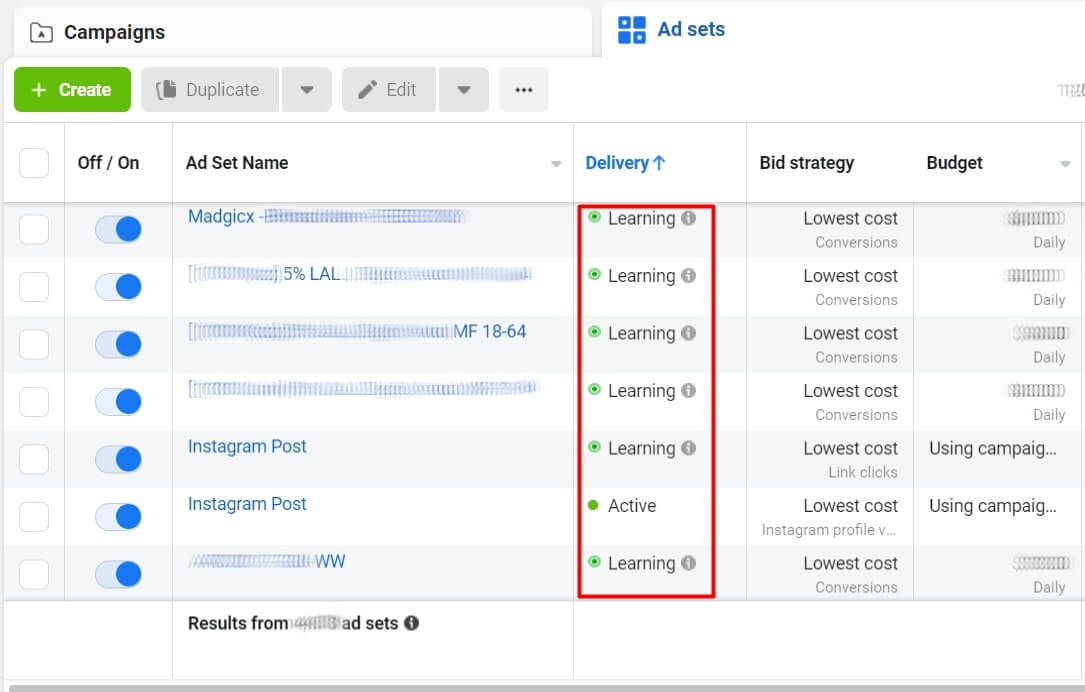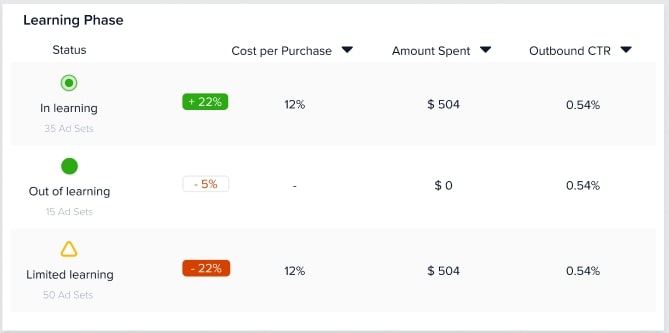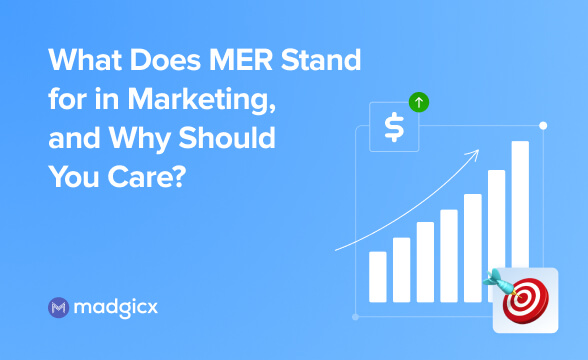A mystery to some, a nightmare to others - the Facebook learning phase has got the online advertising community baffled. Here's what it really is about.
While Facebook ad targeting might seem like magic, a lot of trial and error occurs behind the scenes. When you launch an ad set, Meta’s ads delivery system runs every possible combination of creative, placement, audience, posting time, etc., until it finds the optimal method of delivery for your ad. The analytics might look a little ugly during this phase, but once the delivery system figures your ad set out, its status will shift to active and your cost per action should experience a well-deserved glow up.
The ugly period that lays the foundation for a successful advertising campaign is called the Facebook learning phase. In this post, we’re going to cover everything you need to know about it— what it is, why it’s important, and how to get out of it faster.
What is the Facebook learning phase?
The Facebook learning phase happens right when you create a new ad set or significantly edit an existing one. It’s a period of trial and error where Facebook tests different ways of optimizing your ads to find the combo of creative, audience targeting, time, and place that yields the most conversions. As the Facebook ads delivery system explores all the best delivery methods for your ad set, performance is usually less stable and the cost per action might be higher than it will be in the active phase.
Once your ad set enters the active phase, you’ll have a better idea of how it will perform long-term. That’s when you’ll decide whether to increase your budget, run your ad set as is, or pause it altogether.

How long is the Facebook learning phase?
The Facebook learning phase typically runs until you reach 50 optimization actions in 7 days. Once you pass this threshold, your ad set will transition from “Learning” to “Active” or “Learning Limited.” You can track your learning phase progress in the Delivery column of the Ads Manager. This section shows how long it’s been since you made a significant edit, as well as how far you are from reaching the 50 action threshold.
Optimization actions are determined by the campaign objective you choose when setting up your ad set. As a general rule, ad sets with longer attribution windows will take longer to exit the learning phase. You might benefit from a longer attribution window, though. For example, setting a 1-day click attribution window means all 50 conversions must occur one day after the user clicks your ad.
If your attribution window is typically longer, setting it to just one day keeps those longer conversions from counting towards your 50 and makes your ad seem less effective than it actually is. Your ads might be converting on day two-seven, but the ads delivery system won’t count these toward the 50 conversions required to exit the learning phase unless your attribution window is set to a 7-day click.
What is “Learning Limited”?
Learning limited is the in-between phase. This happens when your ad set isn’t getting enough optimization/conversion events during that first week. Typically, this means that Facebook predicts your ad won’t perform well in the future. This is essentially the ad delivery system’s way of channeling its inner dad to say you aren’t spending your budget effectively.

Learning limited is common for ads with small budgets and/or small audiences. If your ad is running in learning limited and generating good results, you might want to either refrain from making changes or copy the ad set and adjust the new version to test the waters before diving headfirst.
Facebook recommends a few troubleshooting tactics to carry your ads from learning limited to active:
- Combine ad sets and campaigns: according to Facebook, combining ad sets and campaigns can help you reach your desired results faster. The faster you get the results you need, the more stable your results become.
- Expand your audience: a bigger audience means more people to complete your optimization event. Word of warning here, though— increasing your audience so that it isn’t as accurately targeted could end up doing more harm than good. If you follow this recommendation, make sure your audience is still filled with people who are likely to convert.
- Raise your budget: sometimes, your budget is simply too low to reach the 50 optimization event threshold.
- Raise your bid or cost control: similarly, your bid and cost control can also be too low to exit the learning phase.
- Change your optimization event: lastly, Facebook recommends advertisers change the optimization event for ads stuck in the learning limited phase. For example, try changing from Purchases to Add to Cart. Like expanding the audience, this one can get tricky. If Add to Cart actions do not result in enough conversions, you might end up wasting a chunk of your advertising budget.
Once your ad set reaches 50 optimization events since your last edits, it hops from learning limited to active.
Is it necessary to get out of the Facebook learning phase?
Though Meta encourages advertisers to complete the learning phase at all costs, you might want to take this advice with a grain of salt. Be aware that an ad set that isn't driving conversions or has a high CPP won't magically drive better results once its status becomes Active.
While the learning phase does indicate that an ad set hasn't yet driven enough results to prove its worthiness to Facebook, that doesn't automatically mean it has any issues– it could just need more time. If there is something wrong with your ad set, its status will likely shift to learning limited pretty quickly. If you seem far from 50 conversions or are stuck in learning limited, we recommend you try tweaking your creative, ad copy, or target audience before making any drastic budget adjustments.
Overall, you should rely on your KPIs– if your ads are performing well, their official status is arbitrary. If the number of conversions satisfies you or the revenue, there’s no need to rush out of the learning phase.
In the Madgicx app, you can compare performance between ads in the learning phase, active ads, and those that are in “Learning Limited.” That will allow you to effectively assess the connection between the delivery status and your ad set’s performance.

This widget is part of our Auction Insights tool, which lets you analyze your performance according to all the factors you need to look at - from obvious ones such as campaign objective and ad type to those that are often overlooked like frequency and ad delivery optimization.
How to get out of the Facebook learning phase?
Manual optimizations (aka edits) are the main reason why ads fail to exit the learning phase. To get out of the learning phase asap, Facebook recommends the following best practices:
Stop editing your ad sets
While unstable performance tends to make changing your audience, budget, or ad creative look tempting, performance during the learning phase is not necessarily indicative of how your ad will do once it’s active. Every time you make a significant edit, your learning phase resets.
If you don’t give the ads delivery system the time it needs to suss out the optimal placement, format, etc., your ad set will never reach its full potential and you’ll be stuck with shaky learning phase results forever.
For the best (and quickest) results, wait until your ad is out of the learning phase to edit and only make edits when they are necessary to improve performance.
Avoid high ad volume
Running too many ads and ad sets at one time means that each ad delivers less frequently. The result— fewer ad sets exit the learning phase and you spend more of your budget before the delivery system has the chance to fully optimize ad performance. For the best results, try combining similar ads and ad sets. That way, you combine learnings and reach a profitable active phase sooner rather than later.
Consolidating your ad sets consolidates delivery learnings, helping Facebook identify the optimized way to deliver your ads in less time (and using less of your budget to get there).
Avoid high ad set volume by combining ad sets targeting small geographical areas into fewer, larger ad sets. You can also try the store traffic objective. This allows you to target people within a set distance of multiple physical stores in one ad.
If you use multiple ad sets for different placements, consider using Advantage+ Placements (formerly “Automatic Placements“) and asset customization as an alternative strategy. Lastly, consolidate ads or ad sets targeting different languages by setting a single ad set to display in multiple languages.
Set realistic budgets
Setting a budget that is too small or too large can confuse the delivery system. This makes identifying who to optimize for even more difficult for the delivery system, which drags the learning phase out even further.
Start with a budget large enough to get the first 50 optimization events and do your best to limit budget changes once your ad set enters the active phase.
What could send your ads back to the learning phase?
Any significant edits can push ads back into the learning phase. Facebook splits these edits into three categories.
First, you have campaign changes. This includes changing your bid amount, bid strategy, or budget by more than 20%. When using the Advantage Campaign Budget (formerly “Campaign Budget Optimization”), switching your campaign bid strategy can send multiple ad sets within the campaign back into the learning phase. However, slight changes to your budget (under 20% of your current total) are not likely to trigger the learning phase.
Second, you have your ad sets. Avoid changing your targeting, placements, optimization event, adding an ad, or pausing your ad set for more than 7 days.
Lastly, any changes to your ads can send them back into the learning phase. That includes the creative, copy, headline, description, call to action, URL, etc. Even simply adding or altering a disclaimer for ads about social issues, elections, or politics can trigger the learning phase.
Wrapping up
The Facebook learning phase is a mystery to many marketers. Some are even worried or afraid of it and do the best they can to get their ads out of it. But there’s no need to be concerned.
If your ads achieve your KPIs, the learning phase should not be an indicator of success. It does not dictate your performance. It is a mere indicator of the number of conversions your ad set has driven and an arbitrary assessment of Facebook’s ability to accumulate data on your audience and optimize your ad set.
As far as we understand it, creatives, audience targeting, budget allocation, and ad copy, are still the decisive factors in dictating your ad performance. So, focus on them and analyze your KPIs. The learning phase is just another indicator to help you assess performance.
Madgicx lets you see all the crucial factors that affect your Facebook ad performance in one place, including bidding strategies, ad placements, and more - making it easy to optimize your ads and maximize your ROAS.
Martha is a freelance B2B SaaS writer who loves creating strategic blog posts that drive traffic and convert. When she’s not writing about marketing, you can find her petting fluffy cats and reading good books.








%20(1)%20(1).jpg)

